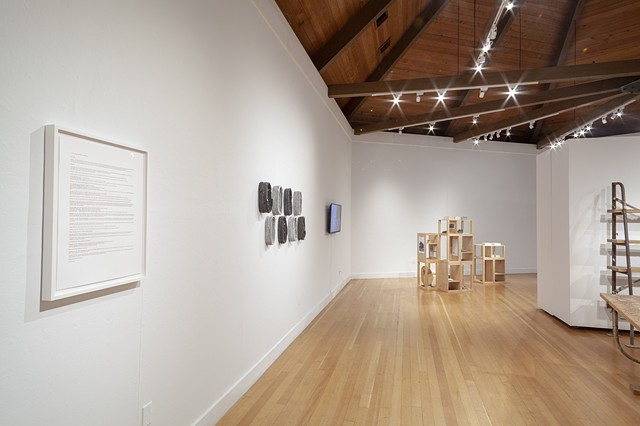Extra Good Showing is a performance piece by Kari where participants sculpt clay based on 1900s correspondence between the architect Julia Morgan and the architectural tile company Gladding, McBean & Co. of Lincoln, California using clay from their site. With each direction given during this fifteen minute piece, the participants engage with a past form of correspondence, connect with a site specific material, and perform an archive. The text was researched at the California State Library’s California History Section and edited by the artist, then screen printed onto watercolor paper, framed, and displayed on the wall.
TEXT EXCERPT
Today we will be performing the archived correspondence, which is in the form of
INTER-OFFICE MEMORANDA, and connect to the same clay body as was used for this project.
I am performing the role of the writer,
the San Francisco office of Gladding, McBean & Co.
I am the middle person between Julia Morgan’s office and you,
the Gladding, McBean & Co. Lincoln, CA office.
You are the fabricators and the factory.
Let's begin.
September 30, 1927 / The Post-Enquirer building in Oakland is set to be built by Julia Morgan. You, the factory, agreed to make shipment from the Lincoln factory in December. This is the first terra cotta order we’ve had from Julia Morgan’s office for many years.
We would like to make an extra good showing on this job.
October 7, 1927 / We are returning the drawing of “THE LILY FEATURED ON THE TILE” which has been approved by the architect without change.
Please sculpt your clay into the shape of a lily petal. Use your thumbs to push out the shape. Now please hold up your piece in the air for inspection.
EVERYONE TO MY LEFT - That’s beautiful!
EVERYONE TO MY RIGHT - Your lily prototypes curve too much. Smush your lilies!
You are now tasked with making a cornice. Imagine an ornamental molding around just below a ceiling. Now begin sculpting your clay into the shape you are picturing.
October 8, 1927 / Miss Morgan wishes you to follow the jointing of the LILY and CORNICE as shown in her drawings.
Find a partner with a sculpted item different from yours.
LILY FIND A CORNICE. CORNICE FIND A LILY. YOU CAN DOUBLE UP IF NEEDED.
Decide where Julia Morgan would want these elements to be joined.
Now push them together. Please have one person hold them in the air while the other person points up to it. Yes, exactly. All of those are correct. Please place them on the table.
ORIGIN STORIES // EXPANDED CERAMICS IN THE BAY AREA
Curated by Tanya Zimbardo
SPRING 2021
Ebitenyefa Baralaye, Sita Kuratomi Bhaumik and María Inés Leal García, The Brick Factory, Ilana Crispi, Futurefarmers, Nicki Green, Dana Hemenway, Kari Marboe, Mutual Stores, Stephanie Syjuco
Spanning the past decade, Origin Stories: Expanded Ceramics in the Bay Area surveys key works by 10 artists and artist groups who consider ceramics in relation to site and place. Select works trace where material comes from in the landscape, while others investigate histories of ceramic production and the movement of objects across international borders.
We begin with works by Kari Marboe and Dana Hemenway that playfully encourage close looking and are installed in relation to the Berkeley Art Center’s unique building. The show moves outward to cultural subjects associated with Berkeley and California, to works first performed in the environment of artists’ neighborhoods, or developed through artist residency programs in the Bay Area.
This exhibition foregrounds the contributions of both interdisciplinary artists and artists who primarily work with clay to a larger and vibrant contemporary field. Several artists bring a conceptually driven approach to functional ceramics, embracing the potential to invite participation and community engagement. For Ilana Crispi and Sita Kuratomi Bhaumik & María Inés Leal García, conversation over tea becomes a vehicle for sharing the story of place.
“THE CUP. THE BRICK. SOME OF THE OLDEST AND SIMPLEST FORMS ARE EMPLOYED HERE IN DIFFERENT WAYS.”
The cup. The brick. Some of the oldest and simplest forms are employed here in different ways. The show is centered on works that are about ceramics itself, moving beyond the traditional capacity of ceramic sculpture to portray something or someone. They draw attention to the basic elements and conditions behind the medium, from the apparatus of the kiln to the byproduct of ceramic waste.
From the collectives Futurefarmers to Mutual Stores, this show highlights the role of collaboration and artist publications as significant forms of expression. The expanded field represented here often embraces the idea of multiple formats and modes of distribution, in-person and online. Certain multiyear projects will continue to unfold and inhabit different spaces.
Several of the artists are not only contemporaries, but taught or studied with one another during the past decade. Related virtual public programs will not only illuminate artist processes, but discuss teaching and making work during a global pandemic. It has been a particularly challenging moment for an inherently communal medium. For the closing weekend, we will host a Bay Area Cup Swap outside the gallery in neighboring Live Oak Park, offering an opportunity for a lively and socially distant form of exchange, open to all makers.
—Tanya Zimbardo, Guest Curator
